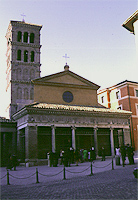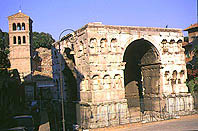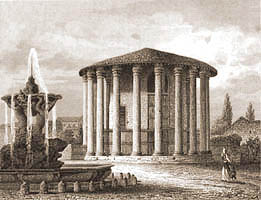Forum Boarium - Ghetto - Tiber Island
![]() Our favorite: we suggest a time walk. Pagan morning walk, Jewish luncheon break and Christian afternoon walk.
Our favorite: we suggest a time walk. Pagan morning walk, Jewish luncheon break and Christian afternoon walk.
We suggest enjoying the day in this area, with a welcome break at one of the fine Jewish / Roman eateries in the Ghetto. (Of course there are many other restaurants in this area).
Remains of Pagan Roman, the Jewish Ghetto and Christian Churches are all intertwined in the usual Roman layers of history.
Forum Boarium: pagan morning walk
The Forum Boarium was literally the cattle market of Ancient Rome. This and the adjacent Forum Holitorium, or vegetable market, were the only markets here before the Roman Forum was drained and built.
Paving stones have been found, situating the two original markets next to the old wall of the Campidoglio and the Arch of Janus to the east. On a hilly rise just before the arch of Janus stood the most fanciful Etruscan temple of them all, with giant buffalo-horn excrescences on the roof.
| Forum Boarium History 8C BC. This area was probably the very first settlement of Rome often flooded as it was situated at a bend in the Tiber. Fortifications were built on the North side from the Campidoglio hill down to the river, and on the South side behind the church of Santa Maria in Cosmedin. The indigenous Etruscans across the water, in Trastevere, fought battles with the early Romans, who, dazzled by their suave neighbors, asked them to be their kings. |
Velabrum
 In ancient times this was the low-lying area between the Roman Forum, the Palatine Hill and the present Church of San Giorgio in Velabro.
In ancient times this was the low-lying area between the Roman Forum, the Palatine Hill and the present Church of San Giorgio in Velabro.
St. Giorgio in Velabrum
Attached to the Moneylenders' Arch, it dates from 683. A century later Pope Zachary brought St. George's head here from Jerusalem where he was decapitated during the persecutions of Emperor Diocletian (284-305).
A Christian officer of the Roman army, his fame rests on the legendary dragon slaying to save a maiden, making him England's Patron Saint in 1348. In Pietro Cavallini's glorious fresco (1295) over the altar, George carries his red-crossed white banner on the far left next to the Madonna, Christ and Saints Peter and Sebastian stand by.
![]() Our favorite: the brilliant and intricate 12C mosaic decoration on the edges of the altar and the reliquary (for the saint's cranium, spear and banner) directly under the altar's delicate baldacchino.
Our favorite: the brilliant and intricate 12C mosaic decoration on the edges of the altar and the reliquary (for the saint's cranium, spear and banner) directly under the altar's delicate baldacchino.
The portico high water mark shows how high the 1870 flood reached (1.3 yards) - and photos inside show reconstruction after the 1993 anarchist bombing. Faith is mightier than affliction.
Arch of Janus

A 4 th Century AD double-facing arch for a two-faced god who protected travelers at crossroads.
It stands directly over the famous drain, Cloaca Maxima, and marked the junction between the Forum Boarium and the Velabrum.
Arch of the Moneylenders
(Arco degli Argentari) Where there's a market, there's money. The Guild of the Moneylenders erected this (on 204 AD) in honor of Emperor Septimius Severus and his family, whose portraits are sculpted on the arch, though two are defaced.
In 212 AD Caracalla lured his brother Geta to their mother's apartments and had him killed while cowering in his mother's arms. Soon after this, Caracalla became sole Emperor and both his brother's and his wife's portraits were effaced from this arch (she too was murdered).
Temple of Vesta

Temple of Hercules Victor (4 Century BC?) formally known as Vesta's Temple.
This round temple, modeled on a hut of wattles and thatched roof, is the oldest marble building in Rome and is represented on ancient coins.
It became a medieval church, S. Stefano delle Carrozze (of the Carts), named for its proximity to the markets.